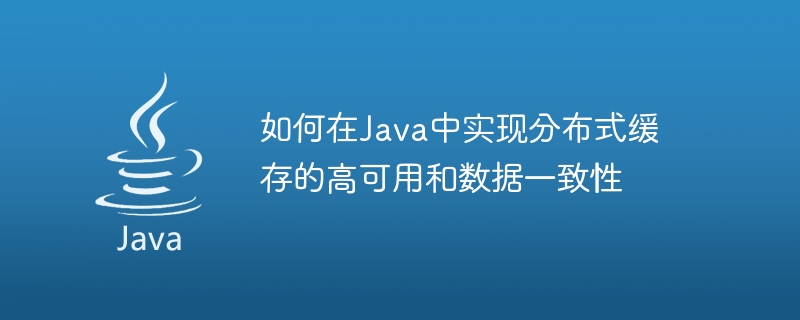Home >Java >javaTutorial >How to achieve high availability and data consistency of distributed cache in Java
How to achieve high availability and data consistency of distributed cache in Java
- 王林Original
- 2023-10-09 20:10:55764browse

How to achieve high availability and data consistency of distributed cache in Java
In distributed systems, caching is a common means to improve performance and reduce database pressure. one. However, single points of failure and data consistency issues are two major challenges that need to be addressed when using distributed caches. This article will introduce how to achieve high availability and data consistency of distributed cache in Java, and provide specific code examples.
1. Implementation of high availability
- Use consistent hashing algorithm
In a distributed cache system, the use of consistent hashing algorithm can make data on multiple nodes are evenly distributed to improve system availability. The basic principle of the consistent hash algorithm is to map nodes and data to a ring. When data needs to be cached or obtained, the corresponding node is found on the ring based on the hash value of the data.
The following is a Java implementation example of the consistent hash algorithm:
public class ConsistentHashing {
private final TreeMap<Long, String> nodes = new TreeMap<>();
private final int replicaNum; // 虚拟节点的数量
private final HashFunction hashFunction; // 哈希函数
public ConsistentHashing(HashFunction hashFunction, int replicaNum, Collection<String> nodes) {
this.hashFunction = hashFunction;
this.replicaNum = replicaNum;
// 添加实际的节点
for (String node : nodes) {
addNode(node);
}
}
public void addNode(String node) {
// 添加虚拟节点
for (int i = 0; i < replicaNum; i++) {
long hash = hashFunction.hash(node + i);
nodes.put(hash, node);
}
}
public void removeNode(String node) {
// 移除虚拟节点
for (int i = 0; i < replicaNum; i++) {
long hash = hashFunction.hash(node + i);
nodes.remove(hash);
}
}
public String getNode(String key) {
if (nodes.isEmpty()) {
return null;
}
// 计算数据的哈希值
long hash = hashFunction.hash(key);
// 在环上找到第一个大于等于该哈希值的节点
Map.Entry<Long, String> entry = nodes.ceilingEntry(hash);
// 如果不存在,则返回环上第一个节点
if (entry == null) {
entry = nodes.firstEntry();
}
return entry.getValue();
}
}
public interface HashFunction {
long hash(String key);
}- Using the heartbeat mechanism
In order to achieve high availability of the cache system, you can use the heartbeat mechanism monitoring Cache the status of the node. Each node sends a heartbeat signal to other nodes at a certain time interval. If a node does not receive a heartbeat signal within a period of time, it is considered to be down and can be removed from the cache node list.
The following is a Java code example that uses the heartbeat mechanism to achieve high availability:
public class Heartbeat {
private final List<String> nodes; // 缓存节点列表
private final long interval; // 心跳间隔
public Heartbeat(List<String> nodes, long interval) {
this.nodes = nodes;
this.interval = interval;
}
public void startHeartbeat() {
ScheduledExecutorService executor = Executors.newSingleThreadScheduledExecutor();
executor.scheduleAtFixedRate(() -> {
for (String node : nodes) {
// 发送心跳信号
boolean result = sendHeartbeat(node);
if (!result) {
// 节点宕机,从节点列表中移除
removeNode(node);
}
}
}, 0, interval, TimeUnit.MILLISECONDS);
}
private boolean sendHeartbeat(String node) {
// 发送心跳信号的具体逻辑
// 返回是否成功接收到心跳信号
return true;
}
private void removeNode(String node) {
// 从节点列表中移除宕机的节点
}
}The above code example demonstrates how to use the consistent hashing algorithm and the heartbeat mechanism to achieve high availability of distributed cache. Availability.
2. Implementation of data consistency
- Use cache update strategy
In a distributed cache system, the cache update strategy is an important method to achieve data consistency. As data is written, data consistency can be ensured by simultaneously updating the cache and database.
The following is Java sample code for using cache update strategy to achieve data consistency:
public class Cache {
public void put(String key, Object value) {
// 写入缓存
// 更新数据库
}
public Object get(String key) {
Object value = null;
// 从缓存读取数据
if (value == null) {
// 从数据库读取数据
// 写入缓存
}
return value;
}
public void delete(String key) {
// 从缓存删除数据
// 更新数据库
}
}- Using version control mechanism
Another way to achieve data consistency Is using version control mechanism. Each time the data is updated, the version number is incremented by one and the version number is stored in the cache along with the data. When reading data, compare the version number in the cache with the version number in the database. If they are inconsistent, read the data from the database again.
The following is a Java sample code that uses the version control mechanism to achieve data consistency:
public class Cache {
private final Map<String, VersionedValue> data = new HashMap<>();
public void put(String key, Object value) {
VersionedValue versionedValue = data.get(key);
if (versionedValue == null) {
versionedValue = new VersionedValue(1, value);
} else {
versionedValue.setValue(value);
versionedValue.incrementVersion();
}
data.put(key, versionedValue);
// 更新数据库
}
public Object get(String key) {
VersionedValue versionedValue = data.get(key);
if (versionedValue == null) {
// 从数据库读取数据
// 更新缓存
} else {
// 比较版本号
// 从缓存读取数据
}
return versionedValue.getValue();
}
public void delete(String key) {
data.remove(key);
// 更新数据库
}
}
public class VersionedValue {
private int version;
private Object value;
public VersionedValue(int version, Object value) {
this.version = version;
this.value = value;
}
public int getVersion() {
return version;
}
public void incrementVersion() {
this.version++;
}
public Object getValue() {
return value;
}
public void setValue(Object value) {
this.value = value;
}
}The above code example demonstrates how to use the cache update strategy and version control mechanism to implement distributed cache Data consistency.
In summary, achieving high availability and data consistency of distributed cache is relatively complex and requires the comprehensive use of consistent hash algorithm, heartbeat mechanism, cache update strategy, version control mechanism and other technologies. Through reasonable design and implementation, the performance and reliability of the distributed cache system can be improved.
The above is the detailed content of How to achieve high availability and data consistency of distributed cache in Java. For more information, please follow other related articles on the PHP Chinese website!

